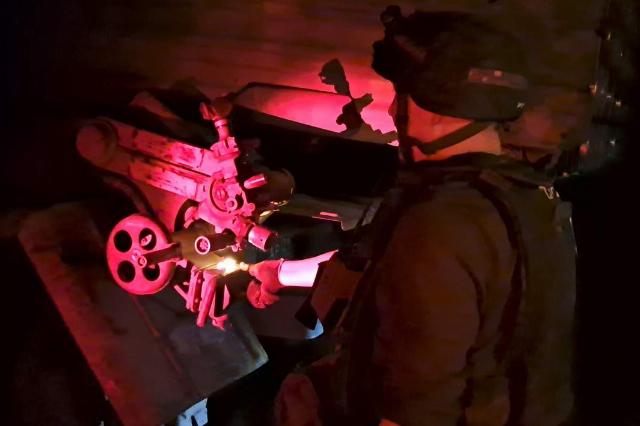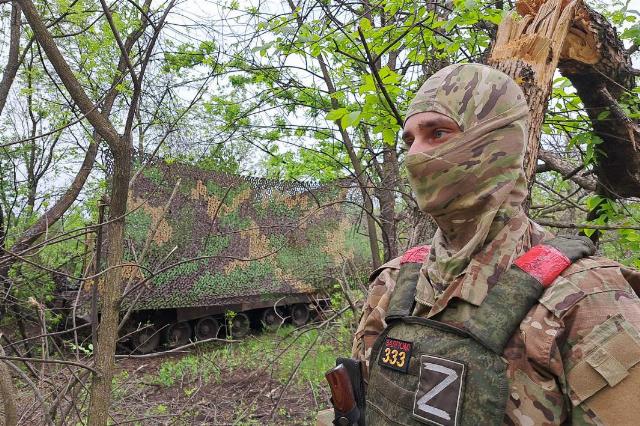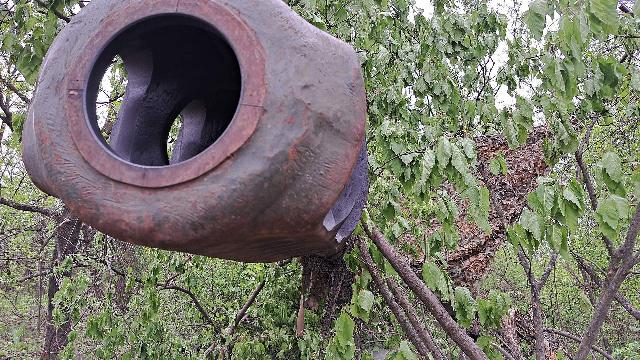How do the gunners support the assault troops' offensives
The success of offensive actions largely depends on the fire support of artillery — on how quickly and accurately the calculations of guns and multiple rocket launchers will complete the task. The correspondent of Izvestia visited the gunners in the Donetsk and Artemivsk directions and saw how combat work takes place in day and night conditions.
Grad's night job
Together with the calculation of the Grad-1 multiple launch rocket system, we move to a firing position at night. We are driving with the weak light of small diodes, so the road is almost invisible. The drone detector screen suddenly lights up - this indicates that the UAV is nearby. The commander decides to go into hiding and wait it out.
According to my feelings, 15 minutes had passed when they reported on the radio that "the sky is ours." We drive on to the desired point, but keeping the blackout. According to the fighters, in addition to small diodes, red lanterns are also used in operations that require light.
It is difficult to find a "tip point" in the dark, so it is indicated by a weak chemical light on a small peg. And if you don't know in advance what it is, then you can simply not notice, even standing at 10 m.

Photo: IZVESTIA/Dmitry Astrakhan
Image source: iz.ru
When we reach the firing point, we jump out of the car and move away so as not to interfere with the calculation. I hear how the brigade receives the command and starts firing shots. After them, there is no point in disguise — the light from the engines of the rockets going into the sky has already given us away. Now everything depends only on the speed of receiving adjustments and the coherence of calculations. The second firing salvo turns out to be successful, and on the radio they command to work out the "package" — the entire ammunition of the installation.
— I've always wondered how artillery works before infantry advances. And I can say now, when I personally see that the interaction of both the senior boss and the calculation is excellent. People work out so fast that I was even surprised," a fighter with the call sign Vinnie told me.
Before transferring to the artillery unit, he was in the assault squad for a long time and knows from his own experience how high-quality fire support changes the situation.

Photo: IZVESTIA/Dmitry Astrakhan
Image source: iz.ru
— It is easier for me to work, because I am aware of the responsibility that lies with the gunners, and the value that stands behind each figure in the adjustment. Understand, there will be a big difference in the assault after shooting perfectly and satisfactorily," he shared.
Vinnie joined the army during the autumn mobilization of 2022, but on his own. He decided to volunteer without waiting for the summons.
On the way to the base, the fighters told me that in the first summer of their night MLRS fire was used to covertly approach the line of contact in conditions of foreign artillery activity and strike at great depth, where the enemy does not expect the work of "Grads". Today, when the enemy's artillery is not so active due to losses and lack of shells, various UAVs become the main means of defeating the enemy. Therefore, the work of the Grads at night has become a common combat task.

Photo: IZVESTIA/Dmitry Astrakhan
Image source: iz.ru
— Now the XXI century, we are adjusting with the help of UAVs, working with tablets. We, the graders, first of all need an accumulation of the enemy. It can be his offensive actions or rotation. The latter take place day and night, so when the UAVs detect them, we immediately work out," says an officer with the call sign Bart.
He volunteered for his military service in July 2022 and, having passed all the steps of the military career ladder, became an officer in combat conditions. Now there are a lot of young people in the artillery who have proved themselves, they are promoted to officer positions, and then they confirm their ranks already in the field. According to Bart, the knowledge gained over two years of fighting is enough for him to fire, although, of course, he had to get used to responsibility in a new status.
Counter-battery "carousel"
In the Donetsk direction, the Central Military District assault detachments, supported by artillery, continue to move forward. Artillery is also being pulled up after the line of contact. After another "rollover", the self-propelled guns quickly settle into new firing positions.
Upon arrival, I immediately began to look for Msta-S cars with my eyes. Despite their impressive size, it turned out to be difficult to visually find them. The commander of the car with the call sign Armeets, seeing my confusion, came up to me and pointed to a howitzer camouflaged in a wooded area and covered from enemy UAVs with nets and vegetation.

Photo: IZVESTIA/Dmitry Astrakhan
Image source: iz.ru
— We are not standing still, we are developing protection against kamikaze drones. The installations have already received additional protection in the form of screens and metal grids. And the car pulls, it does not lose mobility and cross—country ability," the Army man said, patting his gun.
According to him, today the activity of our artillery is several times higher than the activity of the enemy. And in the counter-battery struggle, Ukrainian militants rely almost entirely on kamikaze drones.

Photo: IZVESTIA/Dmitry Astrakhan
Image source: iz.ru
While the Armenian was telling me this, we heard a report on the detection of a UAV in the air on his radio. One of the calculation numbers takes a position with a machine gun at the ready. In the distance, you can hear that another gun continues to work on its targets, but machine guns open fire on an aerial target in several places at once.
Almost immediately after that, the gun also gets a target, and the crew quickly takes up space in the installation.

Photo: IZVESTIA/Dmitry Astrakhan
Image source: iz.ru
— From getting the target to firing, depending on the rotation of the gun, the entire preparation takes less than one minute. After that, we expect an executive team," explains artillery officer Voronezh.
As soon as the air observer reports on the readiness to adjust the fire, the team arrives and the "Msta-S" begins its work. After several shots, the crew stops firing and restores the disguise. While the gunners are going to take cover, it is already heard that another car opened fire in the distance. Such a "carousel" is just one of many measures protecting vehicles and crews from the counter—battery work of the Armed Forces of Ukraine.
Dmitry Astrakhan

